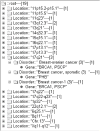Visualizing information across multidimensional post-genomic structured and textual databases
- PMID: 15598839
- PMCID: PMC2901923
- DOI: 10.1093/bioinformatics/bti210
Visualizing information across multidimensional post-genomic structured and textual databases
Abstract
Motivation: Visualizing relationships among biological information to facilitate understanding is crucial to biological research during the post-genomic era. Although different systems have been developed to view gene-phenotype relationships for specific databases, very few have been designed specifically as a general flexible tool for visualizing multidimensional genotypic and phenotypic information together. Our goal is to develop a method for visualizing multidimensional genotypic and phenotypic information and a model that unifies different biological databases in order to present the integrated knowledge using a uniform interface.
Results: We developed a novel, flexible and generalizable visualization tool, called PhenoGenesviewer (PGviewer), which in this paper was used to display gene-phenotype relationships from a human-curated database (OMIM) and from an automatic method using a Natural Language Processing tool called BioMedLEE. Data obtained from multiple databases were first integrated into a uniform structure and then organized by PGviewer. PGviewer provides a flexible query interface that allows dynamic selection and ordering of any desired dimension in the databases. Based on users' queries, results can be visualized using hierarchical expandable trees that present views specified by users according to their research interests. We believe that this method, which allows users to dynamically organize and visualize multiple dimensions, is a potentially powerful and promising tool that should substantially facilitate biological research.
Availability: PhenogenesViewer as well as its support and tutorial are available at http://www.dbmi.columbia.edu/pgviewer/
Contact: Lussier@dbmi.columbia.edu.
Figures






References
-
- Entrez protein database. http://www.ncbi.nlm.nih.gov/entrez/query.fcgi?db=Protein.
-
- Al-Shahrour F, Diaz-Uriarte R, et al. FatiGO: a web tool for finding significant associations of Gene Ontology terms with groups of genes. Bioinformatics. 2004;20(4):578–580. - PubMed
-
- Baker PG, Brass A, et al. TAMBIS-Transparent Access to Multiple Bioinformatics Information Sources. Proceedings of Sixth International Conference on Intelligent Systems for Molecular Biology.1998. - PubMed

